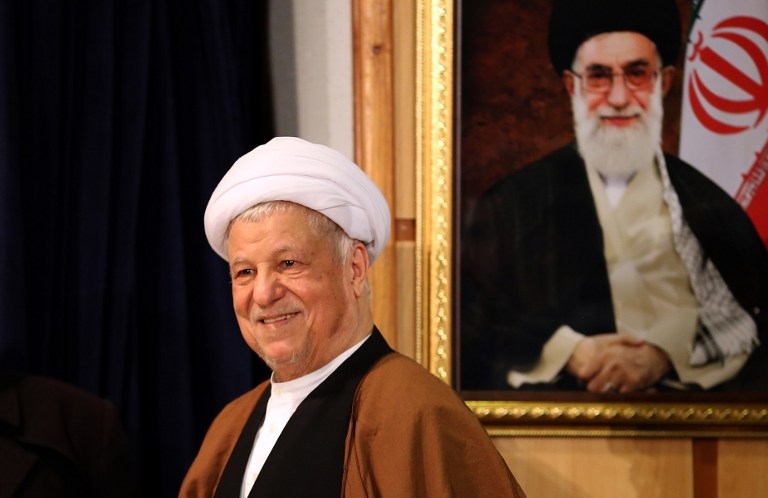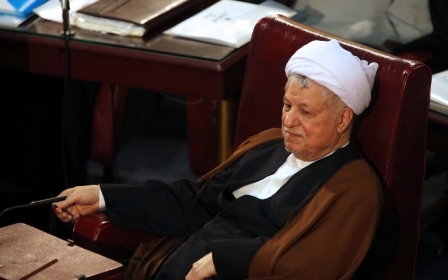Why Iran’s hardliners are afraid of Hashemi Rafsanjani

Eleven years ago, when Iranians were getting ready to head to polls to elect the replacement of the reformist president Mohammad Khatami, who ruled Iran for eight years and steered the country into achieving some international reputation as a peace-loving nation spearheading the global movement of “Dialogue of Civilisations,” the hardliners who had miserably lost grip over the executive branch of the government were thinking of ways to seize back power.
Despite a great deal of division and lack of unanimity, the ultra-conservatives came to a consensus to throw their weight behind Mahmoud Ahmadinejad in the 2005 presidential election. Ahmadinejad was not a recognised and eminent politician. People knew of him as the mayor of Tehran and the former governor of Ardabil Province. Other than that, he hadn’t held major government positions and polls didn’t show him solidly in the lead.
The early pre-voting surveys showed the major contender, former president Akbar Hashemi Rafsanjani in first place, followed by the reformist Mostafa Moin and the former police chief Mohammad Bagher Ghalibaf. However, Ahmadinejad spectacularly won the vote in a run-off contest against his outspoken critic, Rafsanjani.
As opposed to Ahmadinejad, who scended to the presidency thanks to the intensive campaigning of the conservatives and hardliners, his main rival Rafsanjani was an accomplished politician and perhaps one of the most reputable figures of the Islamic Republic. His revolutionary credentials almost equalled those of the Supreme Leader Ayatollah Ali Khamenei.
He was one of the closest companions of the founder of the Islamic Revolution, the late Ayatollah Ruhollah Khomeini, and his activism to oust the Shah and bring the Islamists to power in Iran has been well-documented. Between 1963 and 1978, he was jailed five times by the security and intelligence apparatus of the Shah’s regime, SAVAK.
When the hardliners put all their eggs in Ahmadinejad’s basket and tied their destiny and entire reputation to him, it cost them dearly that Rafsanjani stood strong and defiant, challenging Ahmadinejad since his early days in office, when an atmosphere of intimidation and coercion seized the country, and anyone who dared to criticise Ahmadinejad or publicly question the members of his inner circle was harshly silenced or subjected to retribution.
The conservatives at this time launched a vitriolic smear campaign against Rafsanjani in a concerted effort to take revenge for his challenge to Ahmedinejad. This campaign, which has been on-going since the 2005 polls, and has been intensified in recent years, especially after Hashemi’s close associate Hassan Rouhani was elected president in 2013. Even though Rouhani’s election ushered in a new period of moderation and social, political openness in the country, the hardliners didn’t tone down their attacks on their nemesis.
The hardliners continued virulently attacking Rafsanjani in public, his apparent crime being that he didn’t get along with their idol Ahmadinejad. The megaphones of the conservatives, including state TV, openly accused Rafsanjani and his family of corruption, breeding aristocracy and accumulating illegitimate wealth. This way, they aimed to denigrate him in the eyes of the less-affluent, economically vulnerable groups in society who are potentially sensitive to government officials associated with the landed gentry and charged with having opulent, upscale lifestyles.
The conservatives are well aware that it’s impossible for them to chip away at Rafsanjani’s revolutionary credentials or accuse him of treachery or disloyalty to the establishment, in the same way they marginalised and muted many of the prominent figures of the Islamic Republic in recent years, including former president Khatami, whose name and picture is now officially banned in the public and state media.
Khatami was the president who cemented Iran’s international standing and fostered the country’s global image in the aftermath of the deadly eight-year war with Iraq. He dexterously demonstrated to the world that Iran can be relied on as a normal, productive actor in the community of nations, and foreign investment in Iran’s energy sector reached its apex under him.
The ultra-conservative media in Iran refer to Rafsanjani without using his high-ranking clerical title “Ayatollah” as a way to disparage him. In Iran’s official media discourse, it’s considered an offensive practice to name an ayatollah or grand ayatollah without mentioning their title.
These hardliners who preposterously claim that they’re unconditionally obedient to the Supreme Leader Ayatollah Ali Khamenei simply disregard and disrespect him by flouting his recurrent endorsements of Hashemi since 1979.
On 19 June 2009 and when Iran was boiling in the aftermath of the disputed re-election of Ahmadinejad in the presidential vote, Ayatollah Khamenei used the Friday prayers sermon to publicly authenticate and back up Rafsanjani in the wake of the derisive, scathing attacks Ahmadinejad had launched against him during the campaign season. His comments were lucid, precise and unambiguous:
Everybody knows Mr Hashemi. My acquaintance with him is not limited to the post-revolution era and his appointments after the revolution. I have known him closely since 1957 – that is, 52 years ago. Mr Hashemi has been one of the most principal individuals of the movement at the time of the struggle; he was one of the serious and persistent combatants of the pre-revolution period. After the revolution emerged victorious, he was one of the most effective figures of the Islamic Republic alongside the Imam (Khomeini); following the Imam’s demise, he has been working with the Leader up to now. He has had near-martyrdom experiences several times. Before the revolution, he would spend his wealth for the cause of the revolution and donate to the combatants. It’s good for the youths to know these things. After the revolution, he has maintained several positions. He was president for eight years; before that, he was the parliament speaker; he had other appointments. All through this period, we don’t know of any case when he has accumulated some wealth for himself from the revolution. These are facts. These should be known. During the most critical junctures, he has been serving the revolution and the establishment.
However, the leader’s public approval of Hashemi Rafsanjani fell on the deaf ears of the ultra-conservatives who squandered the nation’s capitals to keep Ahmadinejad powerful.
There are a couple of reasons why the hardliners are ostensibly afraid of Rafsanjani and don’t restrain their defamatory assaults on him.
First, Rafsanjani is evidently the highest-ranking cleric in Iran’s political panorama – even superior to President Rouhani – advocating rapprochement with the United States and West and calling for greater sociopolitical freedoms at home.
Even though some people dislike his family’s lavish lifestyle, he is immensely popular across the country. The fact that his family riches have been the subject of much criticism is purely political; the hardliners and their affiliated media apparatus regularly ignore the corrupt nature and excess wealth of those they wish to uphold and idolise, while exaggerating the same charges against their nemesis and those who don’t fit in their long-term power plans.
Notwithstanding, Hashemi is admired and well-liked nationally. In the recent election for the Assembly of Experts, a clerical body that will choose Iran’s next supreme leader, Rafsanjani came first in the Tehran constituency with an unprecedented popular vote of 2.3 million. His coalition of moderate fellow clerics overwhelmed the Tehran constituency, and 15 members of his list were elected to the Assembly of Experts in an electoral district with 16 seats. It means only one of his associates failed to make it to the assembly.
Rafsanjani gained credit among millions of Iranians during the tumultuous years of Ahmadinejad’s two terms by criticising his populist, adventurous policies.
Now, the hardliners fear that Hashemi might push for some drastic foreign policy change in the future by rallying his supporters around the idea of a fully fledged reconciliation with the United States. Animosity toward the US is essential to the political, economic and ideological survival of these hardliners. In the absence of robust trade ties with the West, they can maintain their economic monopoly domestically without being seriously challenged with the free flow of capital and investment into the country. Moreover, any sort of opening towards the United States will spell doom for their claims to integrity and reliability.
For some 40 years, they have touted the importance of enmity with the US on vague grounds, meaning they will be seriously discomfited if the public favours the advantages of having normal ties with the United States – a bilateral relation premised on respect and mutual benefits, and not necessarily predicated on being colonised or dominated by Washington, as some might fear.
Second, hardliners’ annoyance at Rafsanjani also has to do with his courageous rebellion against Ahmadinejad during the years the latter literally outlawed any criticism of his modus operandi, complicating the nuclear dossier without being seriously contested by the already enfeebled media and a parliament which was completely submissive to him – other than a couple of vocal MPs including Ali Motahari who dared to censure the way he was running the country.
Rafsanjani delivered eye-opening speeches in those years, revealing the widespread corruption in Ahmadinejad’s administration, his pervasive nepotism and the prerogatives he extended to his cronies and entourage. He also questioned Ahmadinejad’s groundless prolongation of hostilities with the United States and the EU and his provocative foreign policy.
The hardliners who literally worshipped Ahmadinejad as a deity who created exceptional economic opportunities for them to accumulate massive amounts of wealth and power under him, were infuriated by Ayatollah Hashemi Rafsanjani’s revelations against their hero, and still cannot disguise their wrath toward him.
Rafsanjani is a pillar of the Islamic Republic, and there’s almost no way to clip his wings or get rid of him – at least as long as he is alive. That’s why the hardliners parochially think of devising ways every other day to disgrace him, like many close allies of the revolution they subdued and eliminated: one day, by accusing him of corruption, and the next day by linking his family members to exiled groups plotting to overthrow the Islamic Republic.
- Kourosh Ziabari is an award-winning Iranian journalist and media correspondent. He is staff writer with Iran Review and a reporter with the California-based Fair Observer. He has also contributed to Huffington Post, Your Middle East, International Policy Digest, Gateway House and Tehran Times.
The views expressed in this article belong to the author and do not necessarily reflect the editorial policy of Middle East Eye.
Photo: Iran's Akbar Hashemi Rafsanjani, in Tehran on 21 December, 2015 (AFP).
This article is available in French on Middle East Eye French edition.
New MEE newsletter: Jerusalem Dispatch
Sign up to get the latest insights and analysis on Israel-Palestine, alongside Turkey Unpacked and other MEE newsletters
Middle East Eye delivers independent and unrivalled coverage and analysis of the Middle East, North Africa and beyond. To learn more about republishing this content and the associated fees, please fill out this form. More about MEE can be found here.





